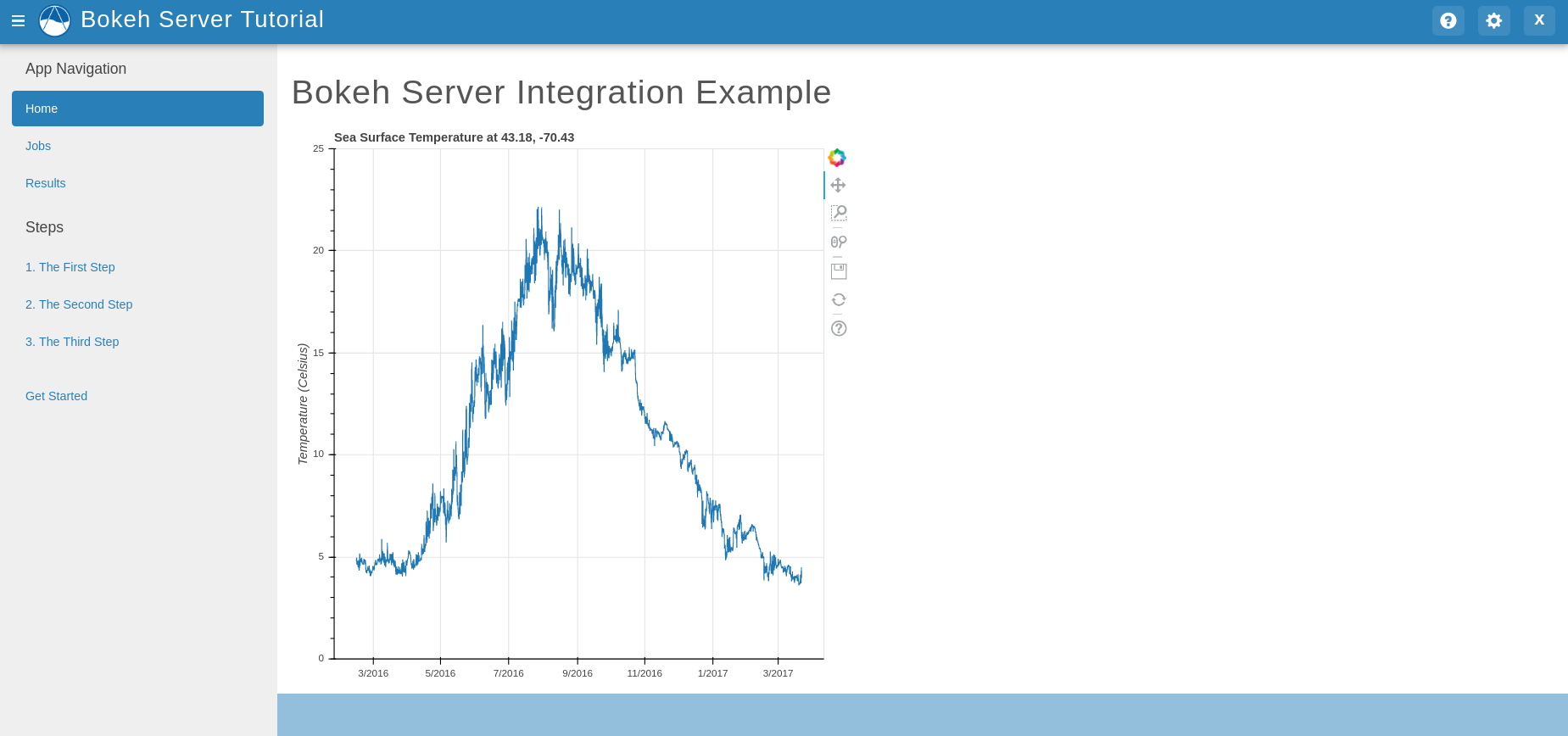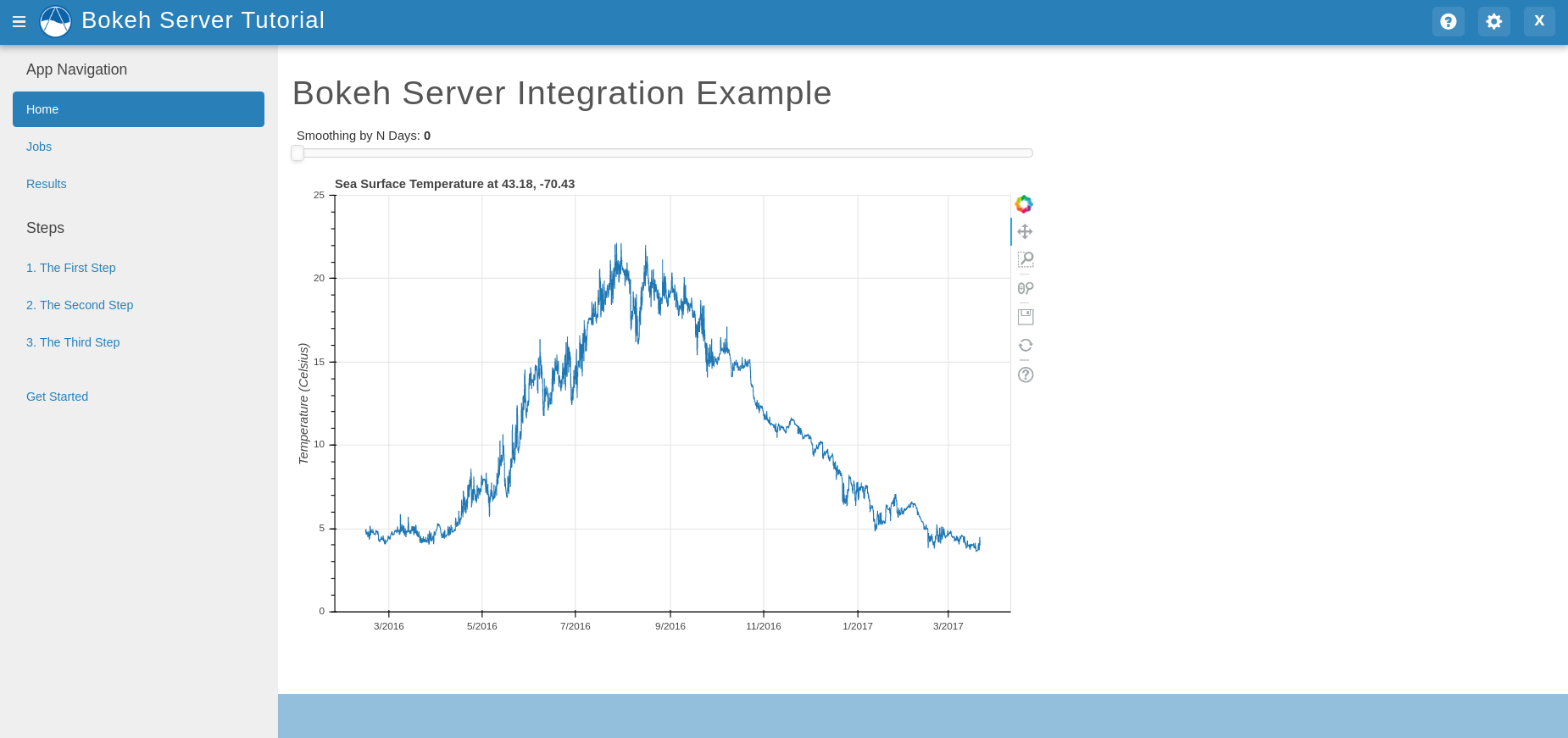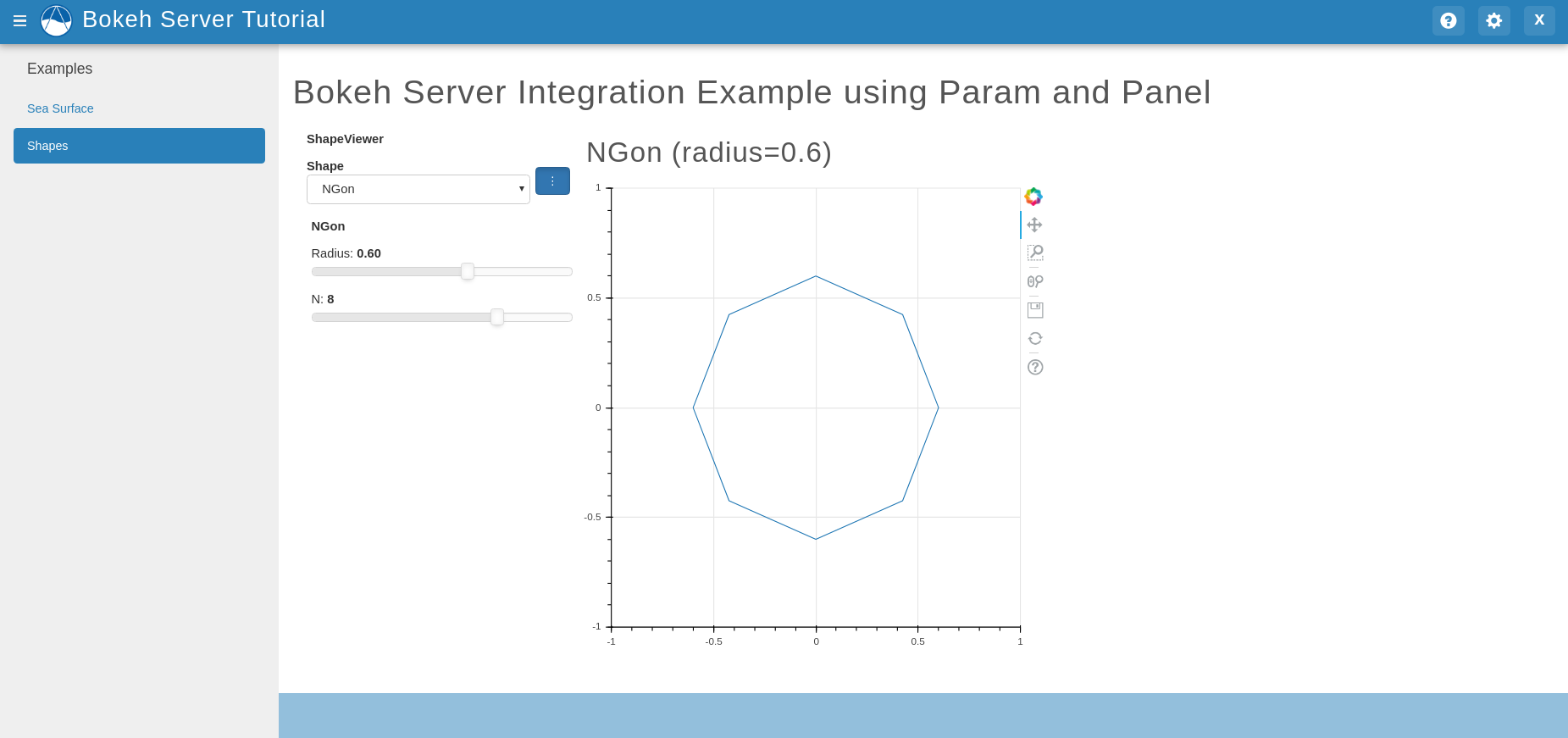Bokeh Integration Concepts
Last Updated: November 2019
This tutorial introduces Bokeh Server integration concepts for Tethys developers. Two bokeh handlers will be created to demonstrate how to link Bokeh plots or widgets to Python functions in the brackground using both a plain Bokeh approach as well as a Param approach. The topics covered include:
Bokeh Server
Handler functions using Bokeh Widgets
Handler functions using Param and Panel
Create and install a new Tethys app named bokeh_tutorial.
conda activate tethys
tethys scaffold bokeh_tutorial
cd tethysapp-bokeh_tutorial
tethys install -d
1. Bokeh Server
Bokeh is an interactive visualization library for Python. Bokeh Server is a component of the Bokeh architecture. It provides a way to sync model objects in Python on the backend to JavaScript model objects on the client. This is done by levering the Websocket protocol. With the addition of Django Channels to Tethys, this ability to sync backend python objects and frontend plots has also been integrated without the need of other components such as a Tornado server (see the Tethys Bokeh Integration documentation Bokeh Integration). This integration facilitates the linking of objects and Bokeh widgets as well as the creation of the necessary websocket and http consumers.
To leverage the Bokeh integration with Tethys you will need the bokeh and bokeh-django libraries.
Install the
bokehandbokeh-djangolibraries by running one of the following commands with your Tethys environment activated:
# conda: conda-forge channel strongly recommended for bokeh (the erdc/label/dev channel is currently needed for bokeh-django)
conda install -c conda-forge -c erdc/label/dev bokeh bokeh-django
# pip
pip install bokeh bokeh-django
Add the new dependencies to your
install.ymlas follows so that the app will work when installed in a new environment:
# This file should be committed to your app code.
version: 1.0
# This should match the app - package name in your setup.py
name: bokeh_tutorial
requirements:
# Putting in a skip true param will skip the entire section. Ignoring the option will assume it be set to False
skip: false
conda:
channels:
- conda-forge
packages:
- bokeh
- bokeh_django
pip:
post:
The logic for creating a Bokeh widget along with other related functionality is provided in a handler function. This handler will be associated to a specific controller function where the resulting Bokeh widget will be displayed in a later step.
2. Handler Functions Using Bokeh Widgets
Let's use Bokeh's sea temperature sample data to create a time series plot and link it to a slider that will provide the value to perform a rolling-window analysis on the time series. This example is based on a similar example in Bokeh's main documentation.
Create a
handler functionby adding the following imports and logic tohandlers.py.
from bokeh.plotting import figure
from bokeh.models import ColumnDataSource
from bokeh.sampledata.sea_surface_temperature import sea_surface_temperature
from tethys_sdk.routing import handler
@handler(
template="bokeh_tutorial/home.html",
)
def home(document):
df = sea_surface_temperature.copy()
source = ColumnDataSource(data=df)
plot = figure(x_axis_type="datetime", y_range=(0, 25), y_axis_label="Temperature (Celsius)",
height=500, width=800, title="Sea Surface Temperature at 43.18, -70.43")
plot.line("time", "temperature", source=source)
document.add_root(plot)
This simple handler contains the logic for a time series plot of the sea surface temperature sample data provided by Bokeh. The handler decorator marks this function as a handler. It auto generates a default controller function that is linked to the handler. A default template can also be used, but we specified a custom template using the template argument to the handler decorator. The handler decorator also sets up the routing. By default the route name and the URL are derived from the handler function name (in this case home). For more information about the handler decorator and additional arguments that can be passed see Handler Decorator. Since this default controller is sufficient, we don't need to create a custom controller and can just delete the controller.py file.
Delete the
controller.pyfile.Clear the default
home.htmltemplate and add the following code to it.
{% extends "bokeh_tutorial/base.html" %}
{% block app_content %}
<h1>Bokeh Integration Example</h1>
{{ script|safe }}
{% endblock %}
As you can see, a script context variable has been added to the app_content block. The default controller function defines this script which handles loading the content specified in the handler function. We customized the template by adding in a heading which will render above the content from the handler function.
If you start tethys and go to the home page of this app you should see something like this:

This is a simple Bokeh plot. We will now add the rest of the logic to make it an interactive plot. We will add a Slider widget. Then, we will create a callback function to modify the time-series plot based on the slider. Finally, we will add both our plot and slider to the document tree using a Column layout.
Modify the
handler functionfromhandlers.pyto look like this.
from bokeh.models import ColumnDataSource, Slider
from bokeh.layouts import column
...
def home_handler(document):
df = sea_surface_temperature.copy()
source = ColumnDataSource(data=df)
plot = figure(x_axis_type="datetime", y_range=(0, 25), y_axis_label="Temperature (Celsius)",
height=500, width=800, title="Sea Surface Temperature at 43.18, -70.43")
plot.line("time", "temperature", source=source)
slider = Slider(start=0, end=30, value=0, step=1, title="Smoothing by N Days")
def callback(attr, old, new):
if new == 0:
data = df
else:
data = df.rolling(f'{new}D').mean()
source.data = dict(ColumnDataSource(data=data).data)
slider.on_change("value", callback)
document.add_root(column(slider, plot))
If you start tethys and go to the home page of this app you should see something like this:

The Slider and Plot will appear in the order they were added to the Column layout. If the value of the Slider changes, the data in the Plot will reflect this change based on this expression: data = df.rolling(f'{new}D').mean(). Where df is the sample data and new is the new Slider value.
3. Handler Functions Using Param and Panel
Param is a Python library for providing parameters with dynamically generated values. One of the main advantages of Param is that parameters are provided using declarative programming. Panel, on the other hand, is a visualization library for creating custom dashboards that rely on the use of widgets to render plots, images, and tables. These libraries can be used in combination with Bokeh Server to attain the same result of creating interactive tools within an app that are connected to Python objects. Given the depth of these libraries, the resulting code structure, and the level of difficulty for creating complex visualizations may be simplified.
In this example we will build on top of the bokeh_tutorial app to demonstrate how to use Param and Panel in combination with bokeh Server. This same example can be found in Panel's documentation.
Install the
paramandpanellibraries by running the following with your Tethys environment activated:
conda install -c conda-forge panel param
Add the new dependencies to your
install.ymlas follows so that the app will work when installed in a new environment:
# This file should be committed to your app code.
version: 1.0
# This should match the app - package name in your setup.py
name: bokeh_tutorial
requirements:
# Putting in a skip true param will skip the entire section. Ignoring the option will assume it be set to False
skip: false
conda:
channels:
- conda-forge
packages:
- bokeh
- bokeh_django
- panel
- param
pip:
post:
Add the following objects to a new file called
param_model.py.
import param
import panel as pn
import numpy as np
from bokeh.plotting import figure
...
class Shape(param.Parameterized):
radius = param.Number(default=1, bounds=(0, 1))
def __init__(self, **params):
super(Shape, self).__init__(**params)
self.figure = figure(x_range=(-1, 1), y_range=(-1, 1), width=500, height=500)
self.renderer = self.figure.line(*self._get_coords())
def _get_coords(self):
return [], []
def view(self):
if not self.figure.renderers:
self.__init__(name=self.name)
return self.figure
class Circle(Shape):
n = param.Integer(default=100, precedence=-1)
def __init__(self, **params):
super(Circle, self).__init__(**params)
def _get_coords(self):
angles = np.linspace(0, 2 * np.pi, self.n + 1)
return (self.radius * np.sin(angles),
self.radius * np.cos(angles))
@param.depends('radius', watch=True)
def update(self):
xs, ys = self._get_coords()
self.renderer.data_source.data.update({'x': xs, 'y': ys})
class NGon(Circle):
n = param.Integer(default=3, bounds=(3, 10), precedence=1)
@param.depends('radius', 'n', watch=True)
def update(self):
xs, ys = self._get_coords()
self.renderer.data_source.data.update({'x': xs, 'y': ys})
shapes = [NGon(name='NGon'), Circle(name='Circle')]
class ShapeViewer(param.Parameterized):
shape = param.ObjectSelector(default=shapes[0], objects=shapes)
@param.depends('shape')
def view(self):
return self.shape.view()
@param.depends('shape', 'shape.radius')
def title(self):
return '## %s (radius=%.1f)' % (type(self.shape).__name__, self.shape.radius)
@param.depends('shape')
def controls(self):
return pn.Param(self.shape)
def panel(self):
expand_layout = pn.Column()
return pn.Column(
pn.pane.HTML('<h1>Bokeh Integration Example using Param and Panel</h1>'),
pn.Row(
pn.Column(
pn.panel(self.param, expand_button=False, expand=True, expand_layout=expand_layout),
"#### Subobject parameters:",
expand_layout),
pn.Column(self.title, self.view)
),
sizing_mode='stretch_width',
)
The added classes depend on Bokeh. The Circle and NGon classes depend on the Shape class, while the ShapeViewer allows the user to pick one of the two available shapes.
Add a
handler functionthat uses the classes created in the previous step by adding the following code tohandlers.py.
from .param_model import ShapeViewer
...
@handler(
app_package='bokeh_tutorial',
)
def shapes(document):
viewer = ShapeViewer().panel()
viewer.server_doc(document)
Note that in this case we are not using a custom template, but we add the app_package argument to the the handler decorator so that the default template that Tethys uses will inherit from the base.html template from our app.
To add the new endpoint to the app navigation bar, go to the
base.htmltemplate and replace theapp_navigationblock content with the code below.
{% block app_navigation_items %}
{% url tethys_app|url:'home' as home_url %}
{% url tethys_app|url:'shapes' as shapes_url %}
<li class="title">Examples</li>
<li class="{% if request.path == home_url %}active{% endif %}"><a href="{{ home_url }}">Sea Surface</a></li>
<li class="{% if request.path == shapes_url %}active{% endif %}"><a href="{{ shapes_url }}">Shapes</a></li>
{% endblock %}
If you start tethys and go to the shapes endpoint of this app you should see something like this:

4. Solution
This concludes the Bokeh Integration tutorial. You can view the solution on GitHub at https://github.com/tethysplatform/tethysapp-bokeh_tutorial or clone it as follows:
git clone https://github.com/tethysplatform/tethysapp-bokeh_tutorial.git cd tethysapp-bokeh_tutorial git checkout -b solution solution-4.2